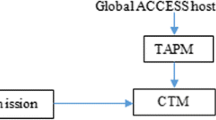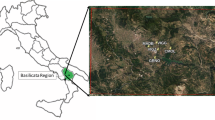Abstract
In this study, the photochemical smog formation over a heavily industrialized area with complex terrain was investigated. A mesoscale prognostic meteorological and air pollution model was used in combination with data, which were collected by in situ and remote monitoring stations. The area of interest is a mountainous basin in north-western Greece. The intensive industrial activity in this area has resulted in effects on the air quality of the area, mainly caused by the lignite-fired power stations and the lignite mining operation. The study focused on the dispersion of ozone production due to primary pollutants’ emissions from the power stations (PSs). Moreover, the investigation of this external sources’ contribution to the ozone concentrations measured in Kozani, the most populated city of the area, is ventured. The results showed a considerable skill of the model in predicting the major mesoscale features affecting the pollutants’ dispersion and concentrations in the area of interest. Numerical simulation data of photochemical pollutants were significantly correlated with meteorology during the simulation period. The correlation reveals the most important factors of ozone production, such as solar radiation, temperature, wind speed and topography. The obtained results have contributed to the verification of distant pollutants’ transfer from industrial sources.










Similar content being viewed by others
References
Allen C, Durrenberger C (2002) Acceleration science evaluation of ozone formation in the Houston-Galveston area. University of Texas
Bernard SM, Samet JM, Grambsch A, Ebi KL, Romieu I (2001) The potential impacts of climate variability and change on air pollution-related health effects in the United States. Environ Health Perspect 109:199–209
Brulfert G, Chemel C, Chaxel E, Chollet JP (2005) Modelling photochemistry in alpine valleys. Atmos Chem Phys 5:2341–2355
Brunelli U, Piazza V, Pignato L, Sorbello F, Vitabile S (2007) Two-days ahead prediction of daily maximum concentrations of SO2, O3, PM10, NO2, CO in the urban area of Palermo, Italy. Atmos Environ 41:2967–2995
Chen KS, Ho YT, Lai CH, Chou YM (2003) Photochemical modeling and analysis of meteorological parameters during ozone episodes in Kaohsiung, Taiwan. Atmos Environ 37:1811–1823
Couach O, Balin I, Jiménez R, Ristori P, Perego S, Kirchner F, Simeonov V, Calpini B, van den Bergh H (2003) An investigation of ozone and planetary boundary layer dynamics over the complex topography of Grenoble combining measurements and modeling. Atmos Chem Phys 3:549–562
Di Sabatino S, Buccolieri R, Pulvirenti B, Britter R (2007) Simulations of pollutant dispersion within idealised urban-type geometries with CFD and integral models. Atmos Environ 41:8316–8329
Dias de Freitas E, Droprinchinski Martins L, da Silva Dias PL, Fatima de Andrade M (2005) A simple photochemical module implemented in RAMS for tropospheric ozone concentration forecast in the metropolitan area of Sao Paulo, Brazil: coupling and validation. Atmos Environ 39:6352–6361
Elbir T, Kara M, Bayram A, Altiok H, Dumanoglu Y (2010) Comparison of predicted and observed PM10 concentrations in several urban street canyons. Air Qual Atmos Health 4:121–131
Gilliliand AB, Hogrefe C, Pinder RW, Godowitch JM, Foley KL, Rao ST (2008) Dynamic evaluation of regional air quality models: assessing changes in O3 stemming for changes in emissions and meteorology. Atmos Environ 42(20):5110–5123
Godowitch JM, Gilliam RC, Rao ST (2011) Diagnostic evaluation of ozone production and horizontal transport in a regional photochemical air quality modeling system. Atmos Environ 45:3977–3987
Hurley P (2005) The air pollution model (TAPM) version 3. Part 1: technical description, CSIRO atmospheric research technical paper no. 71. Available at http://www.dar.csiro.au/TAPM
Hurley P, Manins P, Lee S, Boyle R, Ng Y, Dewundege P (2003) Year-long, high-resolution, urban airshed modelling: verification of TAPM predictions of smog and particles in Melbourne. Australia Atmos Environ 37:1899–1910
Hurley P, Physick WL, Luhar AK (2005) TAPM: a practical approach to prognostic meteorological and air pollution modelling. Environ Model Software 20:737–752
Johnson GM (1984) A simple model for predicting the ozone concentration of ambient air. Proceedings of the 8th International Clean Air and Environment Conference, New Zealand, Clean Air Society of Australia & New Zealand
Kaldellis JK, Kapsali M, Emmanouilidis M (2012) Long-term evaluation of nitrogen oxides and sulphur dioxide emissions from the Greek lignite-based electricity generation sector. Fresenius Environ Bull 21(9):F-2012–F-2197
Ling ZH, Guo H, Cheng HR, Yu YF (2011) Sources of ambient volatile organic compounds and their contributions to photochemical ozone formation at a site in the Pearl River Delta, southern China. Environ Pollut 159:2310–2319
Linkov I, Loney D, Cormier S, Satterstrom FK, Bridges T (2009) Weight-of-evidence evaluation in environmental assessment: review of qualitative and quantitative approaches. Sci Total Environ 407:5199–5205
Moussiopoulos N, Papalexiou S, Sahm P (2006) Wind flow and photochemical air pollution in Thessaloniki, Greece. Part I: simulations with the European zooming model. Environ Model Softw 21:1741–1751
Nam J, Kimura Y, Vizuete W, Murphy C, Allen DT (2006) Modeling the impacts of emission events on ozone formation in Houston, Texas. Atmos Environ 40:5329–5341
Napelenok SL, Foley KM, Kang D, Mathur R, Pierce T, Rao ST (2011) Dynamic evaluation of regional air quality model’s response to emission reductions in the presence of uncertain emission inventories. Atmos Environ 45:4091–4098
Palaciosa M, Kirchner F, Martilli A, Clappier A, Martin F, Rodriguez ME (2002) Summer ozone episodes in the Greater Madrid area. Analyzing the ozone response to abatement strategies by modelling. Atmos Environ 36:5323–5333
Papalexiou S, Moussiopoulos N (2006) Wind flow and photochemical air pollution in Thessaloniki, Greece. Part II: statistical evaluation of European zooming model’s simulation results. Environ Model Softw 21:1752–1758
Peng Y-P, Chen K-S, Wang H-K, Lai C-H, Lin M-H, Lee C-H (2011) Applying model simulation and photochemical indicators to evaluate ozone sensitivity in southern Taiwan. J Environ Sci 23:790–797
Pontiggia M, Derudi M, Busini V, Rota R (2009) Hazardous gas dispersion: a CFD model accounting for atmospheric stability classes. J Hazard Mater 171:739–747
Triantafyllou AG (2001) PM10 pollution episodes as a function of synoptic climatology in a mountainous industrial area. Environ Pollut 112(3):491–500
Triantafyllou AG, Kassomenos PA (2002) Aspects of atmospheric flow and dispersion of air pollutants in a mountainous basin. Sci Total Environ 297:85–103
Triantafyllou AG, Helmis CG, Asimakopoulos DN, Soilemes AT (1995) Boundary layer evolution over large and broad mountain basin. Theor Appl Climatol 52:19–25
Triantafyllou AG, Kiros E, Evagelopoulos V (2002) Respirable particulate matter at an urban and nearby industrial location: concentrations and variability and synoptic weather conditions during high pollution episodes. J Air Waste Manage Assoc 52:174–185
Triantafyllou AG, Zoras S, Evagelopoulos V, Garas S, Diamantopoylos C (2008) DOAS measurements above an urban street canyon in a medium sized city. Glob NEST 10:160–167
Triantafyllou AG, Krestou A, Matthaios V (2013) Source-receptor relationships by using dispersion model in a lignite burning area in western Macedonia, Greece. Glob NEST J 15(2):195–203
Vlachokostas C, Achillas C, Moussiopoulos N, Kalogeropoulos K, Sigalas G, Kalognomou E, Banias G (2010a) Health effects and social costs of particulate and photochemical urban air pollution: a case study for Thessaloniki, Greece. Air Qual Atmos Health. doi:10.1007/s11869-010-0096-1
Vlachokostas C, Nastis S, Achillas C, Kalogeropoulos K, Karmiris I, Moussiopoulos N, Chourdakis E, Banias G, Limperi N (2010b) Economic damages of ozone air pollution to crops using combined air quality and GIS modelling. Atmos Environ 44:3352–3361
Wang X, Carmichael G, Chen D, Tang Y, Wang T (2005) Impacts of different emission sources on air quality during March 2001 in the Pearl River Delta (PRD) region. Atmos Environ 39:5227–5241
Wilmott CJ, Ackleson SG, Davis RE, Feddema JJ, Klink KM, Legates DR, O’Donnell J, Rowe CM (1985) Statistics for the evaluation and comparison of models. J Geophys Res 90:8995–9005
Zhou W, Cohan DS, Napelenok SL (2013) Reconciling NOx emissions reductions and ozone trends in the U.S., 2002–2006. Atmos Environ 70:236–244
Acknowledgments
Financial support was supported by the MADEPODIM programme in frame of TEMPUS III, and computations are done in the Laboratory of Atmospheric Pollution and Environmental Physics (LAP-EP), Technological Education Institute (TEI) of Western Macedonia, Kila, 501 00 Kozani, Greece.
Author information
Authors and Affiliations
Corresponding author
Rights and permissions
About this article
Cite this article
Aidaoui, L., Triantafyllou, A.G., Azzi, A. et al. Elevated stacks’ pollutants’ dispersion and its contributions to photochemical smog formation in a heavily industrialized area. Air Qual Atmos Health 8, 213–227 (2015). https://doi.org/10.1007/s11869-014-0300-9
Received:
Accepted:
Published:
Issue Date:
DOI: https://doi.org/10.1007/s11869-014-0300-9




